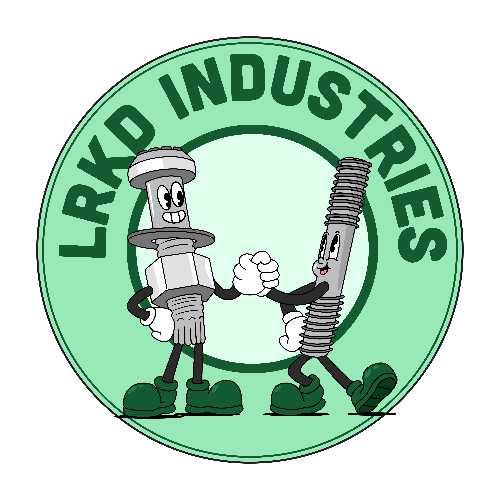Imagine constructing a massive high-rise building, a sprawling bridge, or an industrial facility. The strength of these structures doesn't just rely on visible beams and columns—it starts from the ground up with threaded anchor rods. These unsung heroes play a vital role in stabilizing and securing heavy-duty structures, ensuring they can withstand immense loads, environmental forces, and the test of time.
In this article, we’ll break down what makes threaded anchor rods indispensable in construction, their key specifications, how they support load capacities, and what factors to consider when selecting the right ones for your project.
What Are Threaded Anchor Rods?
Threaded anchor rods, also known as anchor bolts, are long, threaded fasteners embedded in concrete or structural foundations to secure heavy-duty structures. They provide stability by transferring tensile, shear, and compressive loads from the structure to the foundation.
These rods are commonly used in applications such as:
Bridges and overpasses
Steel structures
Industrial equipment anchoring
Telecommunication towers
Wind turbines
Types of Threaded Anchor Rods
There are several types of threaded anchor rods, each designed for specific construction needs:
|
Type |
Description |
Best Applications |
|
L-Shaped Anchor Rods |
Bent at a 90-degree angle for enhanced grip in concrete |
Steel columns, structural beams |
|
Straight Anchor Rods |
Fully threaded rods secured with nuts and washers |
Heavy machinery, seismic applications |
|
Wedge Anchor Rods |
Expands upon tightening, securing itself in place |
Concrete foundations, dynamic loads |
|
Epoxy Anchor Rods |
Bonded using chemical adhesives for extreme holding power |
Retrofits, high-stress applications |
Load Capacities and Strength Considerations
When choosing threaded anchor rods, load capacity is the most critical factor. Engineers must determine the tensile, shear, and pull-out strength to ensure the rod can withstand expected forces.
Factors Affecting Load Capacity:
Rod Material Strength – Higher-grade materials, such as ASTM F1554 Grade 105, offer superior load-bearing capabilities.
Rod Diameter & Length – A thicker and longer rod increases stability and load distribution.
Concrete Strength – The strength of the foundation directly impacts the anchor rod’s performance.
Embedment Depth – Deeper embedment results in greater holding power.
|
Anchor Rod Diameter (inches) |
Tensile Strength (kips) |
Shear Strength (kips) |
|
½" |
6.5 |
3.2 |
|
¾" |
14.8 |
7.6 |
|
1" |
26.4 |
13.5 |
|
1 ¼" |
41.3 |
21.2 |
|
1 ½" |
59.5 |
30.5 |
(Values are approximate and depend on material properties.)
Real-World Example: Bridge Construction
Consider a suspension bridge project where wind loads and vehicle movement create significant stress on the structure. Engineers opt for 1 ¼” ASTM F1554 Grade 105 anchor rods, embedded 24 inches into high-strength concrete. This ensures the bridge can resist tensile forces exceeding 41.3 kips per rod, preventing structural failures.
Key Considerations When Choosing Threaded Anchor Rods
1. Material Selection
Different grades of steel determine an anchor rod’s load-bearing strength and corrosion resistance:
|
Material Grade |
Yield Strength (ksi) |
Tensile Strength (ksi) |
Best Use Case |
|
ASTM F1554 Grade 36 |
36 |
58-80 |
Light-duty applications |
|
ASTM F1554 Grade 55 |
55 |
75-95 |
Medium to heavy-duty structures |
|
ASTM F1554 Grade 105 |
105 |
125-150 |
High-load applications (bridges, wind turbines) |
For outdoor or marine environments, galvanized or stainless-steel rods prevent corrosion and extend longevity.
2. Embedment Depth and Spacing
Proper installation requires:
Sufficient embedment depth (usually 12x the diameter for high loads)
Adequate spacing to prevent concrete cracking
Proper torque tightening to avoid premature failure
3. Environmental Considerations
Seismic Zones: Use high-strength anchor rods with greater ductility.
Cold Climates: Choose materials resistant to brittle fractures.
Corrosive Environments: Opt for epoxy-coated or stainless steel.
Best Practices for Installation
To maximize performance and longevity, follow these installation guidelines:
✔ Drill precisely to ensure accurate embedment depth.
✔ Clean holes thoroughly to remove debris before installation.
✔ Use high-quality adhesives or grouts when needed.
✔ Torque bolts to manufacturer specifications to avoid under-tightening.
✔ Inspect regularly to detect wear, corrosion, or loosening.
Conclusion & Key Takeaways
Threaded anchor rods are an essential foundation component in heavy-duty construction, ensuring structural integrity, stability, and long-term performance. Whether you're working on bridges, steel buildings, or industrial facilities, choosing the right material, size, and installation method makes all the difference.
Key Takeaways:
Material selection (ASTM F1554 Grade 55 or 105) ensures strength and longevity.
Load capacities depend on diameter, embedment depth, and material grade.
Proper installation, torque application, and inspection prevent failures.
Environmental factors like corrosion and seismic activity influence rod choice.
By making informed decisions on threaded anchor rods, engineers and builders enhance safety, durability, and reliability in construction projects.
Need High-Quality Anchor Rods?
LRKD Industries offers top-grade anchor rods built for the toughest applications. Contact us today for expert guidance on selecting the best anchor rod solutions for your next project!
Threaded Anchor Rods Supply Service
Heavy-duty strength starts at the foundation. LRKD Industries proudly supplies Threaded Anchor Rods—crucial, load-bearing components designed to meet the rigorous demands of metal decking and structural steel construction. Ideal for anchoring steel columns, beams, and support structures, our rods ensure unmatched stability, durability, and compliance with engineering standards.
Whether you're reinforcing multi-level steel frames or working on a complex commercial build, trust LRKD’s precision-supplied anchor rods to carry the load—literally.
Contact LRKD Industries now for dependable, high-strength anchoring solutions!
👉 Submit your project requirements today for a FREE consultation and anchor rod supply evaluation.
📍 Address: 98 N Industry CT, Deer Park, NY 11729, US
📞 Phone: +1 646-880-6778
📧 Email: info@lrkdindustries.com
We can also deliver drawings converted into “.dwg” format compatible with Tekla, making it easier for your team to integrate specifications into your design and fabrication workflow.
Click here to explore our full range of anchor rod solutions.
When every connection matters, engineered precision is non-negotiable.


